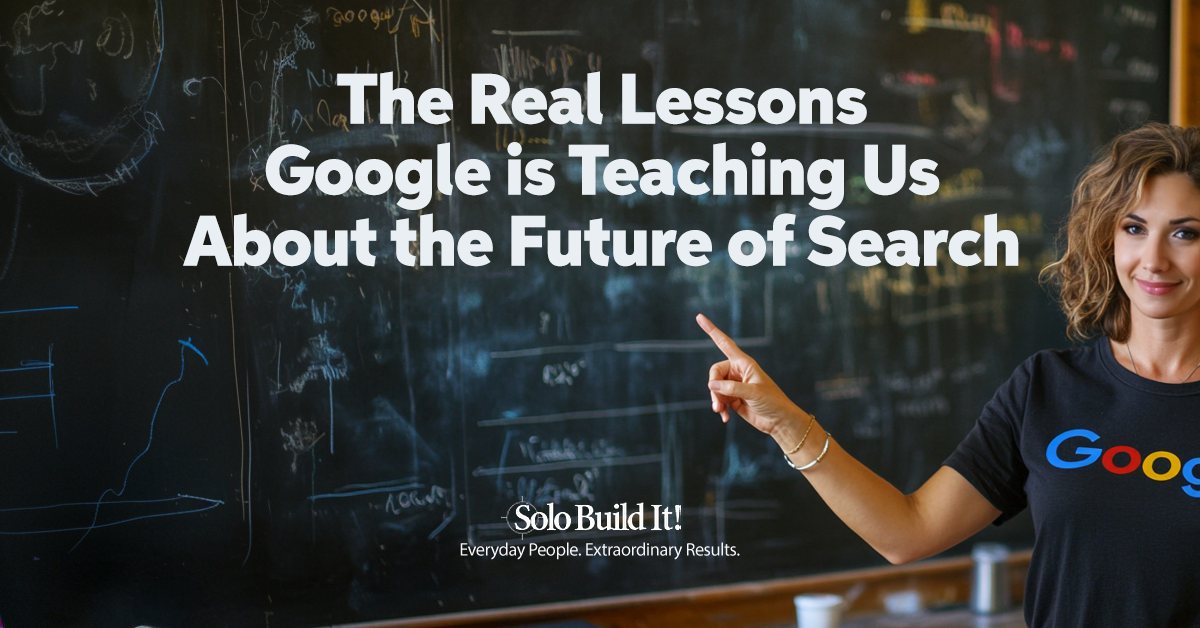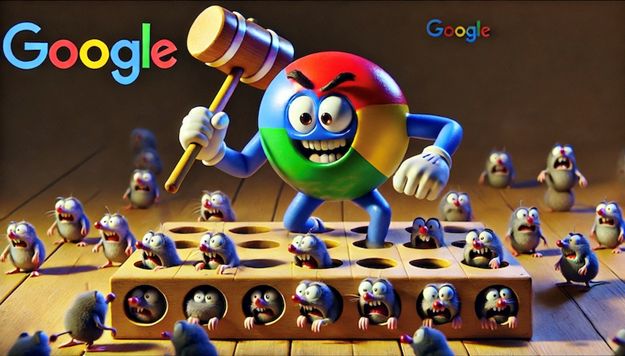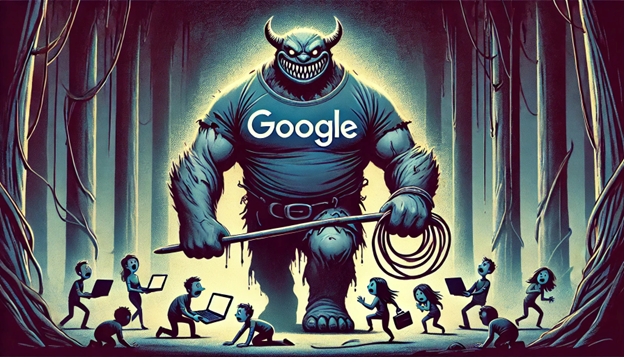Google’s Helpful Content Update (HCU), launched in September 2023, marked a painful turning point for many website owners. As you’re reading this, you might still feel its impact.
Designed to reward “helpful” content, the HCU led to significant traffic drops for many sites, especially those owned by solopreneurs and small businesses.
We felt the pain in the Solo Build It! forums, too. I wanted to help those who suffered substantial losses to regain their rankings, traffic and income. What was initially planned as a single forum post turned into countless hours of research and a 220 page book, “Make Your Site Win (Again!).”
While much has been written about the Helpful Content Update in the months since its roll-out, its fundamental message about Google’s evolving priorities — and how to adapt your content strategy accordingly — is more critical than ever.
We’re in an important transitional period regarding search engines. We’re moving from algorithm-based to AI-based search. More on this in upcoming articles. Subscribe to our newsletter so you don’t miss them.
But first, let’s quickly recap what Google was aiming for with the Helpful Content Update.
“Helpful Content”: We’ve Been Saying This for Years!
In Google’s own words, they wanted to “ensure people see more original, helpful content written by people, for people, in search results.”
Also from Google…
“[A]ims to better reward content where visitors feel they’ve had a satisfying experience, while content that doesn’t meet a visitor’s expectations won’t perform as well.”
That, of course, is what we’ve always taught here at Solo Build It!. You create information for users, not search engines. That means, too, by definition, that search engine optimization is over.
And while Google has been saying this “user-first” mantra for years, the HCU felt different. For many independent bloggers and small site owners, it felt like a penalty.
Were Small Sites Being Penalized for Being Small?
Many smaller websites experienced significant losses in traffic after the September release. There were far fewer sites reporting gains. So, even after allowing for the fact that those who lose traffic are more likely to report, traffic loss far exceeded gains and no changes.
Sites that heavily relied on traditional SEO tactics without prioritizing user value saw massive declines. Small sites with authentic, high-quality content did better but still lost overall. There was little doubt…
Small websites, in particular, experienced drops in traffic and, therefore, revenue.
Whenever I use either of these terms, it means a site built by one to three people, rarely more. “Small” does not refer to the number of pages.
After reviewing countless sites, especially within the SBI! community, I believe the HCU traffic drop wasn’t just “a coincidental collection of anecdotes.” Smaller sites did take a hit, sometimes pushed down by larger sites with arguably inferior content. This led to a “mass uproar,” reminiscent of the Panda and Penguin updates of years past.
What Was Google’s Response?
While Google would never admit that they were wrong, the mass uproar did get their attention. It was enough for them to realize that even if their algorithm yielded better results overall, it created problems elsewhere, as if in a chaotic game of whack-a-mole.
The solution?
There’s more order in the chaos than it seems. Let’s review Google’s response…
Acknowledgment of Impact: Google did acknowledge the impact of the updates, particularly on smaller websites. In several blog posts and webmaster forums, their staff stated that while the updates were designed to reward helpful content, they were aware that some sites were experiencing unintended consequences.
Guidance and Recommendations: Google provided guidance on creating helpful content and improving website quality.
No Reversal or Rollback: Google did not announce any plans to reverse or roll back the Helpful Content Updates. Why would they if they had data to prove that they were achieving what they had intended?
Instead, they reiterated their commitment to rewarding helpful content and improving the overall search experience for users. This is the closest that “typical Google” will ever get to suggesting that future releases may address the “small-site problem.”
Continuous Refinement: Google emphasized that the Helpful Content Update is part of an ongoing effort to refine their algorithms and improve search results. Google encouraged website owners to focus on creating high-quality, user-centric content that aligns with their guidelines.
My thoughts on the above…
While Google admitted that there was an impact on various websites, they denied any errors on their part, as usual. This is classic Google, but I have no doubt that they know there were too many errors here.
This is not the first time that Google or we have been here. Inevitably, Google releases updates that fix the problems, often insisting that all was OK. It’s promising for Google to admit that there’s still work to do.
What was the advice for us?
Google advised site owners to self-assess their content, removing or improving unhelpful content. They stressed that recovery from traffic loss could take several months as the new classifier continuously evaluates site content.
“Remove or improve unhelpful content?”
Well, <doh>…
Big help. 🙄
How Did Site Owners React?
Largely driven by a combination of anger and bewilderment, a recurring theme grew louder that Google was/is intentionally penalizing small sites (i.e., “smallness” is a negative factor in its algorithm).
For this to be true, we’d have to believe that Google no longer wants to offer the best product possible. Instead, they want to plague all smaller sites, even those with best-of-niche content, for reasons unknown to us.
Not likely.
Please… never begin to think that Google wants their search product to be any less good than they could possibly make it. That’s not the way to do any business. And in a business where switching is only a click away, it’s a quick way to lose.
Also, ignore any business that says it has a fast way to grow back lost traffic, no matter how convincing it may sound. Low-lifes always emerge at times like this to take advantage of pain and desperation. Those who follow that road are headed in the wrong direction.
Recovering your traffic requires consistent and regular action over weeks and months. If you find yourself going for the fast fix, review the two Google truths below. Get on the track to recovery.
Two Things We Know Are True About Google
What do you do while waiting for the next algo release or for an improved classifier to re-rate your website?
First, let’s drill down through the cacophony of falsehoods, misinformation and even conspiracy theories, down to what we know to be axiomatically true about Google.

1) What does Google want?
To offer users the best search experience possible.
2) What causes traffic loss?
Sites that lose traffic have lost alignment with the new guidelines.
“Gee Ken, that’s obvious.”
I agree, but that is indeed all there is to it…
When our traffic goes up substantially, we happily pat ourselves on the back for skillfully aligning content with Google’s guidelines.
But, when we lose traffic, puzzlement, weeping and gnashing of teeth spread like wildfire around the globe…
- “How could ^#*&!$@§ Google do this to me?”
- “Suddenly, Google decides that it doesn’t like me now?”
- “Google is out to kill off small sites!”
- “SERPs no longer matter. It just wants to make more cash.”
Suddenly, the two truths are no longer obvious. Google’s new algorithm is wrong, and for all the wrong reasons, right? There’s no way that this release is intended to improve the SERPs, right? Google has agenda items that are more important than offering the best search possible, right?
Wrong. Wrong. And Wrong.
Now, more than ever…
This is the time to return to the two truths.
From there, we can rebuild, using a framework upon which we can confidently restore lost traffic.
Forget SEO: It’s Always Been About Quality, Page by Page
So, what does this alignment look like in practice? Google’s advice, in typical Google fashion, was… well, less than earth-shattering: “Remove or improve unhelpful content.”
But within that seemingly simplistic advice lies a crucial shift. Or maybe it’s not a shift at all, but a re-emphasis of what we’ve always said.
Our advice to SBI! members has always been to keep it real and add value. As I emphasize in MYSWA, “Quality works page-by-page. Google’s core ranking systems are primarily designed to work on the page level.”
This means focusing on OVERdelivering on search intent for every single page on your site. Creating best-of-breed content that truly satisfies your visitor’s needs. Adding long-tail questions, expanding on topics, and ensuring each page is a valuable resource in itself. Forget about just ticking SEO boxes. Think about people.
And yes, this is more work. But it’s also the only sustainable path to long-term success in Google’s search results. And it’s the right way to build an online business you can be proud of.
The Path to Recovery (and Winning Again) is Clear
If your site was impacted by the Helpful Content Update (HCU), or even if you just want to future-proof your online presence in this increasingly AI-driven world, the path forward is clear: focus relentlessly on quality, user-centric content.
Google acknowledges that recovery from traffic loss can take months as their “classifier continuously evaluates site content.” This “ongoing evaluation helps ensure that only consistently valuable content is rewarded over time.” They’re in it for the long haul, and so should you be.
But here’s the good news: recovery is possible. And in “Make Your Site Win (Again!),” I lay out a Traffic Recovery Program designed to help you navigate these changes, reassess your content, and get your site back on track.
This program, detailed in Part 2 of the book, provides a systematic, step-by-step approach to improving your pages, page by page, and aligning with Google’s evolving standards.
As I stated at the beginning: We’re moving from algorithm-based to AI-based search.
The Helpful Content Update was just one signal in this larger shift. To win in this new era, we need to go beyond outdated, superficial SEO tactics and double down on a content-first, user-focused approach.
It’s what we at Solo Build It! always believed in, and now, more than ever, it’s the key to making your site win again.
We’ll publish parts of the Make Your Site Win (Again!) book on our blog in the coming weeks.
Subscribe to our free newsletter below so that you don’t miss them.
Subscribe For Free






